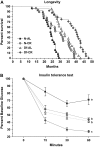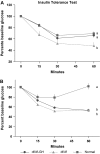Insulin sensitivity as a key mediator of growth hormone actions on longevity
- PMID: 19304940
- PMCID: PMC2667133
- DOI: 10.1093/gerona/glp024
Insulin sensitivity as a key mediator of growth hormone actions on longevity
Abstract
Reduced insulin sensitivity and glucose intolerance have been long suspected of having important involvement in aging. Here we report that in studies of calorie restriction (CR) effects in mutant (Prop1(df) and growth hormone receptor knockout [GHRKO]) and normal mice, insulin sensitivity was strongly associated with longevity. Of particular interest was enhancement of the already increased insulin sensitivity in CR df/df mice in which longevity was also further extended and the lack of changes in insulin sensitivity in calorically restricted GHRKO mice in which there was no further increase in average life span. We suggest that enhanced insulin sensitivity, in conjunction with reduced insulin levels, may represent an important (although almost certainly not exclusive) mechanism of increased longevity in hypopituitary, growth hormone (GH)-resistant, and calorie-restricted animals. We also report that the effects of GH treatment on insulin sensitivity may be limited to the period of GH administration.
Figures




References
-
- Spence JW. Some observations on sugar tolerance, with special reference to variations found at different ages. QJM. 1920;14:314–326.
-
- DeFronzo RA. Glucose intolerance and aging. Diabetes Care. 1981;4(4):493–501. - PubMed
-
- Barbieri M, Rizzo MR, Manzella D, et al. Glucose regulation and oxidative stress in healthy centenarians. Exp Gerontol. 2003;38(1–2):137–143. - PubMed
-
- Brown-Borg HM, Borg KE, Meliska CJ, Bartke A. Dwarf mice and the ageing process. Nature. 1996;384(6604):33. - PubMed
-
- Coschigano KT, Clemmons D, Bellush LL, Kopchick JJ. Assessment of growth parameters and life span of GHR/BP gene-disrupted mice. Endocrinology. 2000;141(7):2608–2613. - PubMed
Publication types
MeSH terms
Substances
Grants and funding
LinkOut - more resources
Full Text Sources
Other Literature Sources
Medical
Miscellaneous

